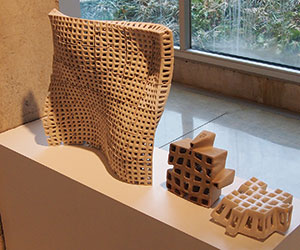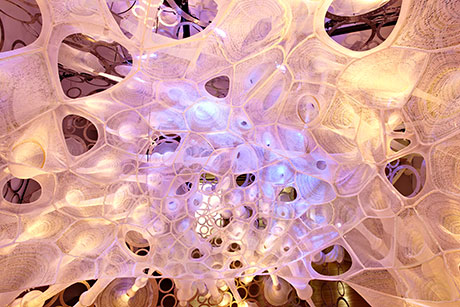Charter Day panelist preview: architect Jenny Sabin
By Sue Brightly
Register for Charter Day events
Charter Day: A Festival of Ideas and Imagination, part of Cornell’s sesquicentennial celebration, runs April 24-27. For event details and registration visit http://150.cornell.edu/charterday.
Jenny Sabin, the Arthur L. and Isabel B. Wiesenberger Assistant Professor in the Department of Architecture, will speak at Charter Day: A Festival of Ideas and Imagination. Her panel, “Seeing and Hearing at the Cutting Edge: The Time of Experience,” will be Sunday, April 26, 9-10:30 a.m. in Alice Statler Auditorium.
What is your panel going to discuss?

We are going to be addressing the topic of time across multiple disciplines. I like to think of the subject of time in the context of what I do as being more like a cloud – it’s not a linear trajectory of moving forward and backward; it’s much more spatial. We have panelists coming from music, science and architecture, and we’ll be looking at the intersections between the humanities and the sciences and the arts. I think it’s going to be a great discussion.
You’ve spoken about the idea of buildings behaving like organisms – what do you mean by that?
One of the questions that drives a lot of my work is how might buildings behave more like organisms, and adapt, and even learn, over time? For example, in matrix biology one studies the extracellular matrix, or the environment that cells communicate through and navigate. One of my collaborative projects is titled eSkin – a hybrid of energy and skin. [We’re] taking human cells and plating them onto organic polymer substrates, and looking at how – if we change pattern, if we change geometry, if we change the material – that in turn influences the behavior of the cells. We’re not going to put human cells on buildings, but it’s giving us some really amazing behavioral models to study that are now influencing the design and engineering of sensors and imagers that learn over time. So in the end, the goal is to have passively responding building skins, thereby enabling the building to behave more like an organism.
Another of your projects involves 3-D printing to make a new kind of ceramic brick.

One of my research tracks is in what I’m calling digital ceramics. Basically we’re questioning the dimensions of the brick, which hasn’t changed in many, many years. With the advent of 3-D printing, we’re able to work with non-standard geometry, so every brick is different. But there's a coherence in how they connect in an overall wall assembly. What we think we’ve produced is the first example of 3-D-printed, mortarless brick wall assemblies. What we’re going to do next is look to nature for some helpful models – looking at bone composites and the lattices that bone is composed of, with an interest in minimizing the weight of these bricks but maximizing durability and strength.
The theme of the Charter Day celebrations is A Festival of Ideas and Imagination. What inspires your imagination?
I think there’s a huge paradigm shift occurring in architecture that’s going to radically change how we make and construct buildings. Historically, architecture and the sciences and engineering were never separate. The architect was a kind of master builder, working with craftspeople on site where design was not separate … it was very much integrated. For the first time, some say since the medieval period, the architect is being positioned back in the role of a “maker” again. Here, design, making and constructing exist in one inextricably linked loop. And that’s how nature works, right? Pattern, geometry, materiality, environment – all of those dynamic scenarios are linked together; it’s not one or the other. What we’re seeing is a shift away from the Cartesian world that we live in, of buildings with standardized tectonic elements – the column, the beam, the arch – and now we can start to look at much more non-standard, organic and beautiful structures and forms. I get extremely excited about that.
How has working at Cornell influenced your creativity or your work?

What I really admire and love about Cornell is the openness to collaboration and collegiality. As a research institution, it’s a place that’s open and conducive to transdisciplinary work and research. I have incredible support from my colleagues here in architecture – and I’m not a typical architect, you know, so that hasn’t always been the case in the past. Collaboration across disciplines is really hard. And I wouldn’t be able to do what I do without my students. That’s a big component to what I do – I certainly don’t work alone! I have an incredible team.
Sue Brightly is the content manager in the Division of Human Resources and Safety Services.
Media Contact
Get Cornell news delivered right to your inbox.
Subscribe